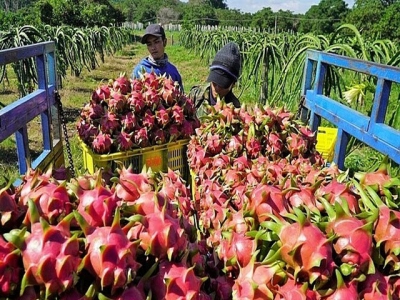China is changing drastically, giving up the habit of seasonality to trade agricultural

Technical barriers on standards, quarantine, food safety and hygiene of countries in general and China in particular are increasing day by day. Enterprises exporting agricultural and aquatic products still maintain the habit of seasonality and fragmentation, which is not suitable for China's drastic changes.
The Ministry of Agriculture and Rural Development announced on September 13, 2021, in the first eight months of the year, the export of agricultural, forestry and fishery products to China was estimated at over US$6 billion, up 21.7% over the same period in 2020; imports reached US$2.1 billion, up 50.3% over the same period in 2020.
Deputy Minister of Agriculture and Rural Development Phung Duc Tien said that in terms of market opening, Vietnam has done a good job of negotiating to cut import taxes under the ASEAN-China Free Trade Agreement.
However, many key agricultural products with advantages have not been officially licensed and opened the market in technical terms by China yet as durian, sweet potato, passion fruit, custard apple, pomelo, bird's nest, salted jellyfish, black tiger shrimp, frozen white shrimp to take advantage of these offers.
Notably, in terms of customs clearance at the border gate, China strengthens strict control the border gate area to prevent and control the Covid-19 pandemic, which has affected the customs clearance of Vietnam's goods.
The Ministry of Agriculture and Rural Development will assume responsibility and coordinate with the Ministry of Foreign Affairs, the Ministry of Industry and Trade in promoting market opening and adding products for export to China (durian, sweet potato, passion fruit, custard apple, pomelo, bird's nest) into the content of high-level leadership talks between the two countries to speed up progress.
At the same time, the General Department of Customs of China maintains recognition of growing areas, farming areas, packaging and processing establishments of agricultural and aquatic products that have been allowed to be exported after the date of Order 248 (issued in accordance with the Decree No. "Regulations on the management of registration of foreign food production enterprises imported into China") and Order 249 (promulgation of "Measures to manage food safety for import and export of China") comes into effect (January 1, 2022).
Besides leading and guiding localities, industry associations and enterprises to meet the provisions of the Chinese side in the effective Order 248 and Order 249; guiding the registration of exports to China under new regulations on assurance of labels, traceability, indications of growing areas, testing, quarantine, packaging specifications, quality and types of agricultural products.
In addition, the Ministry of Agriculture and Rural Development said that the Ministry of Industry and Trade will guide localities with key planting areas to coordinate with border provinces and China to reasonably regulate the amount of goods in the harvest season and bring them to the border gates to avoid congestion, price pressure and damaged goods, especially seasonal fruits.
According to the Ministry of Agriculture and Rural Development, localities need to reorganize production to ensure the source of goods have high quality and added value, especially origin traceability, control food hygiene and safety and quarantine to develop sustainable exports to the Chinese market
“Border localities with land border gates need to actively coordinate with ministries, sectors and provide local guidance to support businesses in solving difficulties in warehouses, storage of agricultural products, transportation services, commercial logistics at border gates; establishing bonded warehouses, storage warehouses, and e-commerce services at border gates to promote circulation and consumption of exported agricultural products," Deputy Minister Phung Duc Tien said.
Related news
 Vietnamese farmers are keenly interested in digitization
Vietnamese farmers are keenly interested in digitization A survey conducted by CropLife Asia in four ASEAN countries shows that Vietnamese farmers' interest in digitization is at a much higher rate than the rest.
 Pepper industry makes five recommendations to overcome difficulties amidst pandemic
Pepper industry makes five recommendations to overcome difficulties amidst pandemic The ideas stem from the prolonged Covid-19 pandemic, which is expected to have a significant effect on pepper companies' export operations.
 Restoring production, connecting circulation to save farmers and businesses
Restoring production, connecting circulation to save farmers and businesses Enterprises operating "3 on the spot" models can only maintain about 30-40% of employees, so productivity drops sharply, affecting the consumption